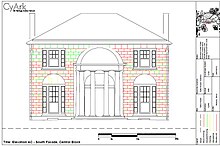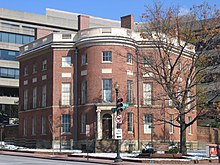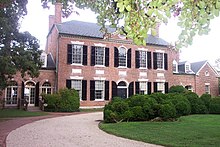Architect[edit]
United States Capitol[edit]
In 1789, after briefly practicing medicine and pursuing an interest in steamboats, Thornton submitted a design to the architectural competition for the Library Company of Philadelphia's new hall.[1] His design won but was somewhat departed from during actual construction. Library Hall was described as the first building in the "modern [classical] style" to be erected in the new nation's leading city.
During his visit to Tortola between October 1790 and October 1792, Thornton learned of the design competitions for the U.S. Capitol and the "President's House" to be erected in the new Federal City on the banks of the Potomac. Because a design for the Capitol had not been chosen, he was allowed to compete upon his return to Philadelphia. Between July and November 1792, the Washington administration examined closely the designs submitted by the French émigré architect Etienne Sulpice Hallet, (1755-1825), and Judge George Turner. Hallet and Turner had been summoned to the Federal City in August 1792 to present their ideas to the "Commissioners of the District of Columbia" and local landholders. Both were then encouraged to submit revisions of their designs to accommodate new conditions and requirements. At the beginning of November, Turner's new designs were rejected.
The painter John Trumbull handed in William Thornton's still "unfinished" revised plan of the Capitol building on January 29, 1793, but the President's formal approbation was not recorded until April 2, 1793. Thornton was inspired by the east front of the Louvre, former royal palace later turned art museum, as well as the Pantheon, famed former Roman temple in Roma and later converted to a Christian church, for the center portion of the design.[7] After more drawings were prepared, enthusiastic praise of Thornton's design was echoed by Secretary of State Jefferson: "simple, noble, beautiful, excellently distributed." For his winning design, Thornton received a prize of $500 and a city lot.[8]
The execution of the design was entrusted to the supervision of Étienne Sulpice Hallet and James Hoban, (1758-1831), (who had also submitted designs for the "President's House - later the White House). Hallet proceeded to make numerous revisions, including removing the rotunda under which Washington was to be enshrined upon his death. So, on September 12, 1794 the President appointed Thornton as one of the three "Commissioners of the Federal District" in charge of laying out the new federal city and overseeing construction of the first government buildings, including the Capitol of which he became supervisor and remained in charge until 1802. Despite important changes and additions, (especially the substitution of a lower copper-clad wooden dome during the 1820s to 1856, for Thornton's original design), especially by second Architect of the Capitol, Latrobe and third Architect Bulfinch, much of the design of the facade of the central portion of the Capitol is his.
Other works[edit]
As a consequence of winning the Capitol competition, Thornton was frequently asked to give ideas for public and residential buildings in the Federal City. He responded with designs on several occasions during his tenure as a commissioner, less so after 1802 when he took on the superintendency of the Patent Office.
It was during this time he was asked to design a mansion for Colonel John Tayloe. The Tayloe House, also known as The Octagon House, in Washington, D.C., was erected between 1799 and 1800. It served as a temporary "Executive Mansion" after the 1814 burning of the White House by the British and the house's study was where President Madison signed the Treaty of Ghent ending the War of 1812. In 1899 the building was acquired by the American Institute of Architects, whose national headquarters now nestles behind it.
Around 1800, he designed Woodlawn for Major Lawrence Lewis (nephew of George Washington) and his wife, Eleanor (Nelly) Parke Custis (granddaughter of Martha Washington), on 2,000 acres (8.1 km2) of Mount Vernon land. Sometime around 1808, he designed Tudor Place for Thomas Peter and his wife, Martha Parke Custis (another granddaughter of Martha Washington).
National Register[edit]
Many buildings designed by Thornton have been added to the National Register of Historic Places including:
- Library Company of Philadelphia, 5th & Chestnut Sts., Philadelphia, PA; 1789 (demolished 1887; recreated as Library Hall, American Philosophical Society, 1954)
- United States Capitol, Washington, DC; 1793 - exempt
- Prospect Hill, NE of Long Green on Kanes Road, Baltimore, MD; 1796-1798 - added to registry in 1973
- Octagon House, 1741 New York Avenue, NW, Washington, DC; 1799 - added in 1966
- Woodlawn, W of jct. of U.S. 1 and Rte. 235, Fairfax, VA, 1800-05 - added in 1970
- Tudor Place, 1644 31st Street, NW, Washington, DC; 1816 - added in 1966
Superintendent of the Patent Office[edit]
Upon the abolition of the board in 1802, President Jefferson appointed Thornton the first Superintendent of the Patent Office. When Washington was burned by the British in 1814, Thornton convinced them not to burn the Patent Office because of its importance to mankind. He held the position from June 1, 1802 until his death in 1828 in Washington, DC. During his tenure, he introduced innovations including the patent reissue practice, which survives to this day.[9]
Some of Thornton's reputation as an inventor is due to abuse of his position in the Patent Office. His improvements to John Fitch's 1788 steamboat are patented but didn't work. [10] When John Hall applied for a patent on a new breech-loading rifle in 1811, Thornton claimed he had also invented it. As proof, he showed Hall a Ferguson rifle, a British gun dating from 1776, refusing to issue the patent unless it was in his name as well as Hall's name.[11]







No comments:
Post a Comment